Ancestors in the City? Find Them (and More!) in City Directories
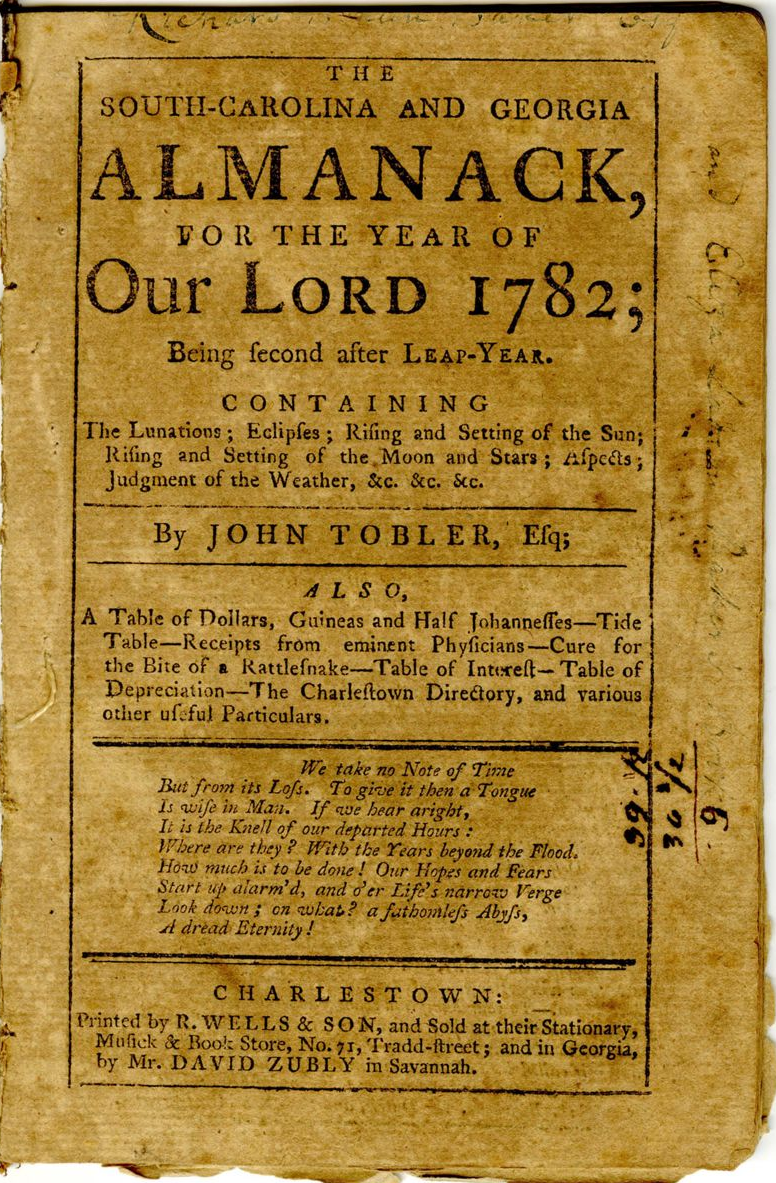
City directories were created for salesmen, merchants, and others interested in contacting residents of an area. They’re especially helpful for genealogical research in large cities, where a high percentage of the people were renters, new arrivals, or temporary residents. A directory may be the only source to list an ancestor if he or she was not registered to vote and did not own property.
These publications are a gold mine for genealogists. They can tell you much more than simply where a family or an individual lived. Depending on the directory, and whether you follow a string of directories chronologically, you could find:
- Head of household and spouse
- Children over 18, and other residents, be they family or not
- First appearance of an immigrant
- If person was owner, renter, or boarder
- Occupations of residents
- Name and death date of a resident and name of surviving spouse (around 1930)
- Widows listed by mid-1800s
- Employed women
- Military veterans
- Middle initials
- List of deaths from previous year; persons ‘too late for insertion’
- Civic, fraternal, and religious organizations
- Schools, churches, hospitals, asylums, orphanages, cemeteries, and newspapers
- Street maps with ward boundaries
- Reverse listings by street name
- Business ads
- Proof of a name change
- Date of removal from one city to another
The earliest known “city directory” was printed in New York in 1665. It included 255 names of households, mostly Dutch, and was arranged by the name of the street on which they lived. You can see it in the digitized book The Memorial History of the City of New York, From Its First Settlement to the Year 1892, Vol. 1, pp. 338-340. No other directory is known to exist until 1752. At that time a Baltimore newspaper printed a list entitled “The Following List of Families, and Other Persons Residing in the Town of Baltimore, Was Taken in the Year 1752, By a Lady of Respectability,” which was published in the March 1947 issue of the Maryland Historical Magazine.
The next directories were included in almanacs printed in Charleston, South Carolina in 1782 (featured image at beginning of this post) and 1785. The thirty-two-page 1782 almanac for South Carolina and Georgia contains a Charleston City Directory but also shows the Charleston Board of Police, information about planting, homemade remedies, and weather forecasts.


The first known singular directory (not part of an almanac) was Francis White’s Philadelphia Directory, published in Philadelphia in 1785 (Fig. 1), which includes a fairly well-known Founding Father (Fig. 2).
From the beginning, city directories contained interesting, informative, and even unusual information. They are a snapshot in time, a reflection of the time and place in which they were produced. Thomas Jackson’s 1789 Boston Directory (Fig. 3) includes locations of public offices and who kept them; names and residences of doctors and lawyers; bank officials and bank hours; names and residences of enginemen (very likely operators of steam engines); and a map of Boston. Fig. 4 shows the first page of householders and businessmen listed in the 1789 Boston Directory.
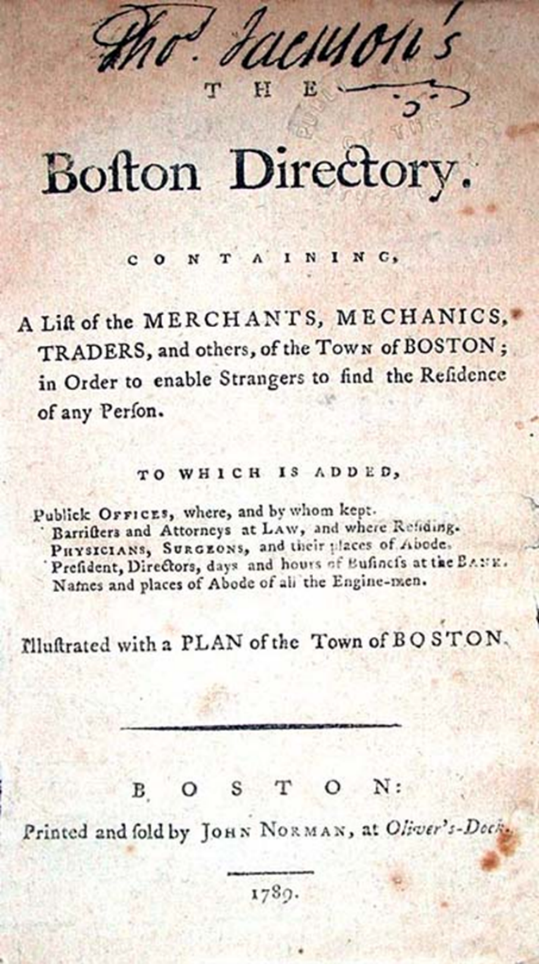
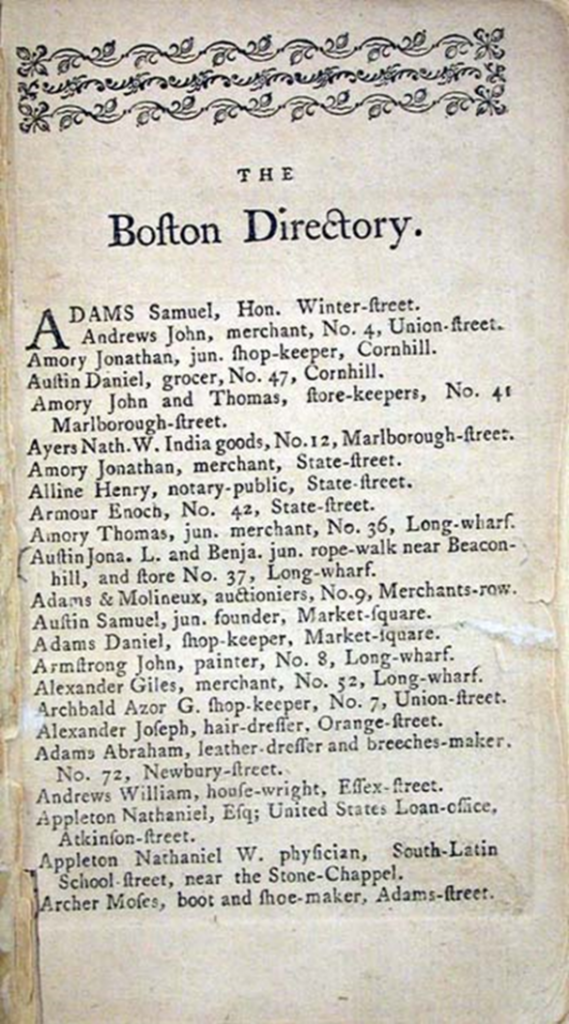
The 1827 Directory of the Village of Rochester [New York] lists only male inhabitants over age fifteen and displays boarders and households in separate columns on each page. Boarders are identified on the left with their occupations and the households in which they board (Fig. 5), and householders are listed on the right, with their occupations and residences (Fig. 6). The directory also includes a current map of the village as well as its history from 1812-1827 and its Act of Incorporation of 1826.
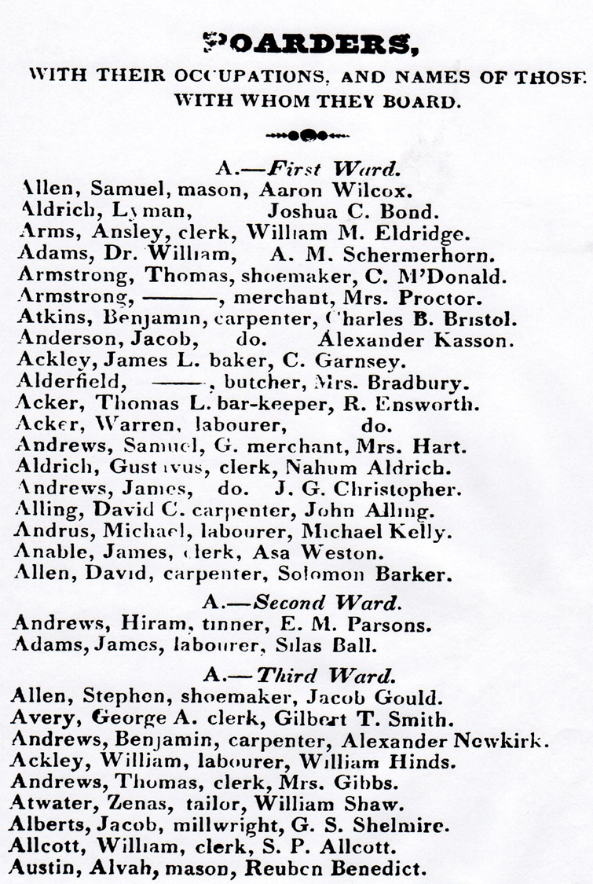
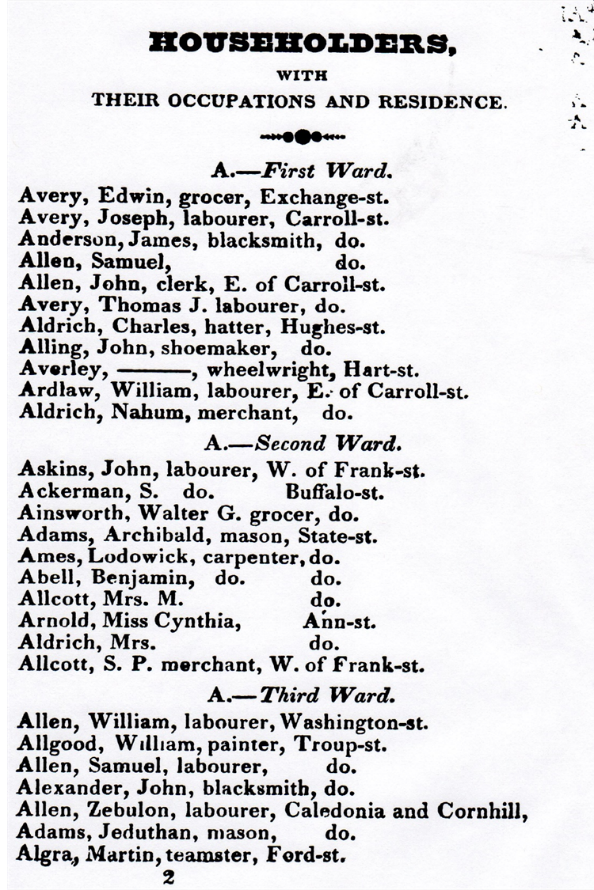
The 1850 directory of Newark, New Jersey (Fig. 7) provides insight into the current state of the community’s health. It includes the number of burials in 1849 divided by gender, by age group, by type of disease, and with summary totals of nationalities of the deceased. Among the many entries are lists of the city’s doctors and nurses.
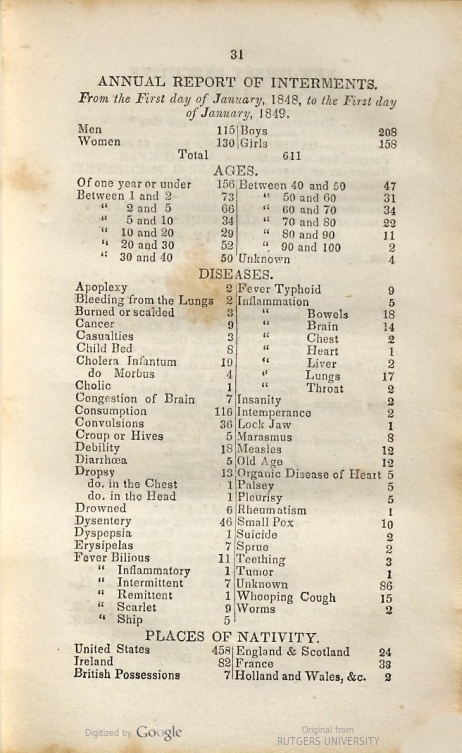
By 1860 over seventy directories were published at regular intervals. The Directory for the Borough of Chester [Pennsylvania], for the Years 1859-1860, for example, included widow status (wid) and race (col) to further define the population (Fig. 8). Most city directories have a list of abbreviations at the front. When using older directories, you can consult genealogical dictionaries to find contemporaneous meanings of old terminologies.

As beneficial as directories are to genealogical research, it’s important to understand their nature and limitations. Start by checking the directory’s contents lists first to see what information it contains. You might find that it’s not alphabetized accurately. Entire ethnic neighborhoods may be excluded. If you’re checking competing directories for a city, one city, one may include different information than the other. Women not working outside the home may not appear in early directories. Children under 18 are not included, and young people 18 and over are listed as students only if they attend college or trade school. As happened during a census, people may not have been home when directory compilers stopped by. Directory information may have come from either a home visit or from voter registration lists. Other limitations may be that directories list the occupant and not the owner of the property.
Street names may have changed over time or may have been renumbered in later directories; some directories include these changes to help their users. Occupants might have refused to answer questions, and immigrants may not have spoken or understood English. There may be variant spellings and typographical errors as well. It’s also important to remember that directory data predates the publication date by one year and is valid only for the time the directory was compiled.
As with so many genealogical resources, directories can be springboards to additional resources. Think about what to do with what you find in a directory. If a person is the owner of the property, check property purchase and/or sale records. If a death date is given, check for death certificates and obituaries. If an employer is listed, search for the person’s employment records. If searching for an immigrant ancestor whom you know settled in a certain city, checking consecutive years of a directory could reveal the first time the immigrant appears. Knowing that date means you could then search passenger lists and naturalization records for additional information about that person.
City directories can also help prove relationships or separate identities of persons with the same names or initials, especially with occupations. The criss-cross listing of residents by street name may show family members with different surnames residing in a household.
Moving into the twentieth century, here’s an example of several tidbits of information that can be gleaned from the 1930-1931 Waltham [Massachusetts] City Directory entry for Solomon J. and Bessie Pliskin (Fig. 9). We learn that Bessie Pliskin died on August 1, 1930 and that she was the wife of Solomon J. Pliskin listed immediately below. Solomon was a tailor who worked at 143 Prospect in Waltham and had a house at 82 Prospect.
Since this directory also has a criss-cross section arranged alphabetically by street name, we also learn that another family, Mr. and Mrs. Louis Belkin, was boarding with the Pliskins (Fig. 10). In fact, Louis Belkin is the Pliskins’ son-in-law and. Mrs. Belkin is their daughter Miriam Pliskin. Note Solomon’s incorrect middle initial in Fig. 10, but he’s clearly the same person as shown in Fig. 9. If we look for Louis Belkin in this directory, we find him and Miriam listed residing at 82 Prospect and working as a tailor at 314 Moody St. (Fig. 11).



These are just a very few examples of the wealth of information in city directories. If you have urban ancestors, these publications should be high on your list of resources to investigate. You can find them in several places. Check free online digital collections such as FamilySearch, the Internet Archive, HathiTrust, and Google Books, as well as subscription sites such as Ancestry, MyHeritage, and Fold3. If you’re using FamilySearch, go to https://www.familysearch.org/en/wiki/United_States_Directories and scroll down to “Directories by State” and click on the state name. Ancestry covers 1821-1989; search the card catalog for “U.S., City Directories, 1822-1995.” MyHeritage covers 1860-1960; search for “U.S. City Directories, 1860-1960,” and Fold3’s coverage varies by location. Grapevine Library subscribes to Ancestry Library Edition and Fold3, which you can use for free in the Genealogy Room. Fold3 is also currently available free of charge to Texas library cardholders through the Texas State Library TexShare database program; contact the library for more information about this. Cyndi’s List is another great way to locate city directories online.
Additional digital and/or print access to city directories may be available through public, university, and special libraries, and genealogical and historical societies. As an example, you can find an alphabetical list of Texas city directories held at the Texas State Library in Austin. The free Portal to Texas History currently has 180 digitized Texas city directories. The ultimate resource for city directories is the Library of Congress which owns the largest collection of these publications in electronic, microfiche, microfilm, and print formats.
Following are some additional resources to help identify city directories:
City Directories of the United States. New Haven: Research Publications, Inc. 1971- .
City Directories of the United States, 1860-1901: Guide to the Microfilm Collection. Woodbridge, CT: Research Publications, 1983.
Spear, Dorothea N. Bibliography of American Directories Through 1860. Worcester, MA: American Antiquarian Society, 1961.
Also, the United States Online Historical Directories web site identifies historical city, county, business and other directories available online on both free and for-pay web sites.
No study of urban ancestors is complete without consulting city directories. Take full advantage of these gems wherever you find them.





Recent Comments